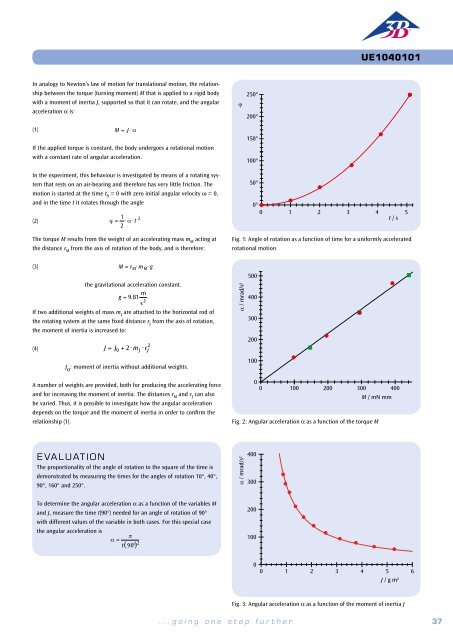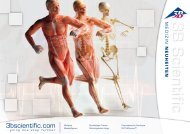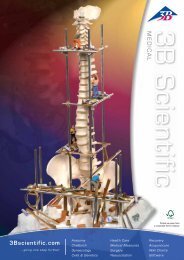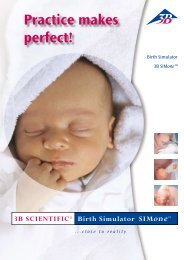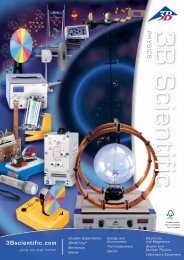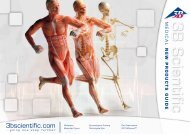3B Scientific - Physics & Engineering Experiments
3B Scientific - Physics & Engineering Experiments
3B Scientific - Physics & Engineering Experiments
Create successful ePaper yourself
Turn your PDF publications into a flip-book with our unique Google optimized e-Paper software.
UE1040201<br />
Mechanics / Rotational Motion<br />
Moment of Inertia<br />
UE1040201<br />
BASIC PRINCIPLES<br />
The inertia of a rigid body that acts against a change of its rotational<br />
motion about a fixed axis is described by the moment of inertia J. It<br />
depends on the distribution of weight in relation to the axis of rotation.<br />
The greater the distance of a weight from the axis of rotation the greater<br />
also is the moment of inertia it causes.<br />
EVALUATION<br />
From (2) the following equation is derived to determine the moment of<br />
inertia:<br />
2<br />
T<br />
J = Dr<br />
⋅<br />
2<br />
4 π<br />
In the experiment, this is investigated using the example of a rotating disc<br />
carrying a horizontal rod, to which two additional weights of mass m are<br />
attached symmetrically at a distance r from the axis of rotation. For this system<br />
the moment of inertia is:<br />
(1)<br />
2<br />
J = J0 + 2 ⋅ m⋅<br />
r<br />
J o<br />
: moment of inertia without the additional weights.<br />
If the rotating disc is coupled elastically by a coil spring to a rigid stand, the<br />
moment of inertia can be determined from the period of torsional oscillation<br />
of the disc about its rest position. The relationship is as follows:<br />
(2)<br />
T<br />
= 2π⋅<br />
J<br />
D r<br />
D r<br />
: torsional coefficient of the coil spring.<br />
Thus, the greater the moment of inertia J of the disc with the attached horizontal<br />
rod, as dependent on the mass m and the distance r, the longer the<br />
period of oscillation T.<br />
Fig. 1: Moment of inertia J of rotating disc with horizontal rod as a function<br />
of the square of the distance r from the axis of rotation for three different<br />
additional weights of mass m<br />
E X PERIMEN T<br />
PROCEDURE<br />
OBJECTIVE<br />
Determine the moment of inertia of a horizontal rod with additional weights attached<br />
• Determine the torsional coefficient D r<br />
of the coupled spring.<br />
• Determine the moment of inertia J as a<br />
function of the distance r of the added<br />
weights from the axis of rotation.<br />
• Determine the moment of inertia J as<br />
a function of the value m of the added<br />
weights.<br />
SUMMARY<br />
The moment of inertia of a body about its axis of rotation depends on the distribution of its weight in<br />
relation to the axis. This is to be investigated for the case of a horizontal rod to which two additional<br />
weights are attached symmetrically about the axis of rotation. The rod is coupled to a torsion spring,<br />
and its period of oscillation increases as its moment of inertia, which is determined by the additional<br />
weights and their distance from the axis, is raised.<br />
required apparatus<br />
Quantity Description Number<br />
1 Rotating System on Air Bed (230 V, 50/60 Hz)<br />
Rotating System on Air Bed (115 V, 50/60 Hz)<br />
1000782 or<br />
1000781<br />
1 Supplementary Kit for Rotating System on Air Bed 1000783<br />
1 Laser Reflection Sensor 1001034<br />
1<br />
1 Digital Counter (230 V, 50/60 Hz)<br />
Digital Counter (115 V, 50/60 Hz)<br />
1001033 or<br />
1001032<br />
38 <strong>3B</strong> <strong>Scientific</strong>® <strong>Experiments</strong><br />
...going one step further<br />
39


